It looks like you're using an Ad Blocker.
Please white-list or disable AboveTopSecret.com in your ad-blocking tool.
Thank you.
Some features of ATS will be disabled while you continue to use an ad-blocker.
share:
One of the key developments of the Neoltihic Period is the practise of the domestication of animals and plants, programmes of selective reproduction
that produce sought after physical and behavioural modifications, that facilitates the exploitation of these species and increases the potential of
one's own.
Whilst as i said this is one of the key aspects of Neolithic development, the evidence from the earliest Neolithic period suggests that this was a gradual process at several key sites that only occured once other social factors were in place, that other criteria had to set this in motion within those communities.
What is never considered is that those human societies themselves were first made aware of the potential of selective reproduction due to their being a product of such, a highly heretical consideration, despite there being evidence to support such.
It has become increasingly evident in recent years that a new people arose in the core Neolithic region of Northern Syria/Anatolia that went on to become the Eurasians, that Indo-European languages and culture trace back to that region, that genetic traits such as blue eyes, blonde hair, whiteness, date back to the onset of the early Neoltihic period.
Science provides the means for observing and dating such changes, archeology provides the context and evidence
, this of course requiring interpretation. The only principles generally considered are those of chance and circumstance, but in my opinion these in themselves give rise to the consideration of agenda.
We need to look then at what the evidence says occured;
.
NEOLITHIZATION AND THE HUMAN BODY
As can be seen at the end of the quote, the given reason for these profound changes from the core Neolithic region is that a 'genetic bottleneck' had occured, which is to say a great many diverse variations went into the mix, but what emerged was of a more particular nature, which is of course what one will observe with any programme of selective breeding.
The changes then are notable, yet the question remains what gave rise to such, one should thus look to the archaelogical evidence to see if anything can be discerned;
Community Structure at Neolithic Çatalhöyük:
Thus one sees that the manner in which a society such as Catalhoyuk was set up might provide some insight into as to why a new population type occured, this is the aspect that needs to be furthur considered.
It was James Melaart who first proposed the great Goddess theory of Anatolia, due to the abundance of fertility type Goddess figurines, but this i think needs more specific context, this being that there is much iconography at Catalhoyuk showing interest in cellular geometric pattern based on the hive of the honeybee, and it can be proposed that this was their basis for living accomodation/town planning.

It was long considered that one mural at Catalhoyuk was a town plan with volcano seen in the background, more recently its been re-considered as hive pattern iconography with leopard skin above, but the mistake would be easily made, as can be seen were this is compared to Australian aborigine honeycomb pattern.
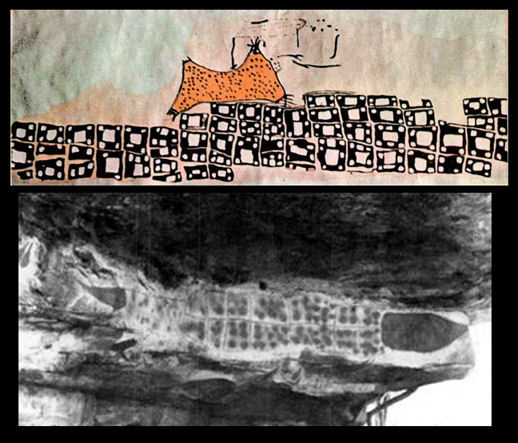
If it can be seen that the design for living was after the honeybee, then one also needs to re-consider the role of the 'great Goddess' in terms of the Queen Bee.
What the establishment of such a set up would provide is that one could maintain a contolled strain, in terms of a breeding programme, were singular mothers are understood as responsible for generating a particular type, and thus elevated in status, thus the adapation of this model provides a means for controlled reproduction and establishes the premise in nature.
Whilst as i said this is one of the key aspects of Neolithic development, the evidence from the earliest Neolithic period suggests that this was a gradual process at several key sites that only occured once other social factors were in place, that other criteria had to set this in motion within those communities.
What is never considered is that those human societies themselves were first made aware of the potential of selective reproduction due to their being a product of such, a highly heretical consideration, despite there being evidence to support such.
It has become increasingly evident in recent years that a new people arose in the core Neolithic region of Northern Syria/Anatolia that went on to become the Eurasians, that Indo-European languages and culture trace back to that region, that genetic traits such as blue eyes, blonde hair, whiteness, date back to the onset of the early Neoltihic period.
Science provides the means for observing and dating such changes, archeology provides the context and evidence
, this of course requiring interpretation. The only principles generally considered are those of chance and circumstance, but in my opinion these in themselves give rise to the consideration of agenda.
We need to look then at what the evidence says occured;
Piontek and Vančata did in 2002 study the skeletal material from many of the areas that were affected by the neolithization. They found a great difference between the pre-neolithic and the neolithic groups in body size, body proportions, bone shape and robustness.
Combined with biological and ecological studies on the prehistoric environment (which the humans lived in), many anthropologists still discuss whether the changes of the Neolithic human body were only due to evolution, or if migration in some form should still be considered. This of course changes from area to area, but morphologically there seems to be some pronounced differences between the late Palaeolithic or Mesolithic skeletons and the Early Neolithic, in several parts of Europe. The changes are not only seen in the cranial form, but also in the limb proportions etc. These changes are explained as either genetic (migration) or ecological (evolution).
Cranial measurements show that the Mesolithic cranial forms are a mixture of the Palaeolithic and the Neolithic types. Thus some of the morphological changes around the neolithization must definitely be due to adaptation, and should therefore be seen as answer to both climatic changes and the effects of the changed diet (evolution due to ecological factors). This however still cannot explain why some groups change profoundly while others don’t - even though they all undergo the same cultural changes!
Studies on cranial morphology in Anatolia and the Levant reveal that the first farmers were a very mixed group. A variation like this is not known from the rest of Europe. This could be due to a genetic bottle neck among the Anatolian groups that only led a small genetic variation through to Europe.
.
NEOLITHIZATION AND THE HUMAN BODY
As can be seen at the end of the quote, the given reason for these profound changes from the core Neolithic region is that a 'genetic bottleneck' had occured, which is to say a great many diverse variations went into the mix, but what emerged was of a more particular nature, which is of course what one will observe with any programme of selective breeding.
The changes then are notable, yet the question remains what gave rise to such, one should thus look to the archaelogical evidence to see if anything can be discerned;
There appears to be evidence for the division of the site along two main descent groups, or moieties.
These groups appear to be phenotypically distinct based on dental metrics and morphology, and they were physically separate from each other living at opposite ends of the site, north and south.
These groups likely exchanged mates with each other, although it is more likely that females were brought in from other sites.
Differences between males and females within Çatalhöyük and between Çatalhöyük, Aşıklı Höyük, and Musular indicate that Çatalhöyük likely participated in a patrilocal post-marital residence practice.
It appears that females were migrants from other sites in the region and that males were the less mobile sex within Çatalhöyük and without. In other words, males did not appear to emigrate from or migrate to Çatalhöyük at the scale that females appear to have done both.
The authors of this study suggest that there was a genetic bottleneck in Central Anatolia as populations moved into Europeand their data supports an exogenous origin of European Neolithic farmers.
It could, therefore, be possible that the Neolithic sites of Çatalhöyük and Aşıklı Höyük are in fact ancestral populations to this late sample, and other later populations.
This study found that house interment was only minimally related to biological affinity and that ties to the home were not solely based on biology.
It is likely that burial location choice, and by inference, the social structure of Çatalhöyük was much more complex and incorporated a different meaning of kin than one based solely on familial relations
Community Structure at Neolithic Çatalhöyük:
Thus one sees that the manner in which a society such as Catalhoyuk was set up might provide some insight into as to why a new population type occured, this is the aspect that needs to be furthur considered.
It was James Melaart who first proposed the great Goddess theory of Anatolia, due to the abundance of fertility type Goddess figurines, but this i think needs more specific context, this being that there is much iconography at Catalhoyuk showing interest in cellular geometric pattern based on the hive of the honeybee, and it can be proposed that this was their basis for living accomodation/town planning.

It was long considered that one mural at Catalhoyuk was a town plan with volcano seen in the background, more recently its been re-considered as hive pattern iconography with leopard skin above, but the mistake would be easily made, as can be seen were this is compared to Australian aborigine honeycomb pattern.

If it can be seen that the design for living was after the honeybee, then one also needs to re-consider the role of the 'great Goddess' in terms of the Queen Bee.
What the establishment of such a set up would provide is that one could maintain a contolled strain, in terms of a breeding programme, were singular mothers are understood as responsible for generating a particular type, and thus elevated in status, thus the adapation of this model provides a means for controlled reproduction and establishes the premise in nature.
edit on 31-8-2012 by Kantzveldt because: typo
What needs to be considered then is who first suggested or introduced the practise, for the establishment of communities taking the bee as model,
archaeology at present has no explanation for the development of cellular accomodation around a central communal/birthing house, some examples of
which have all the charm of a prison cell, compared with the more understood principle of the large extended family dwelling.
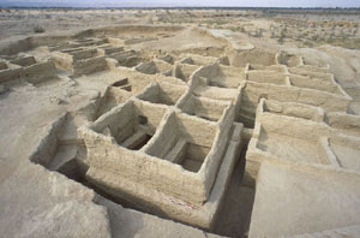

This only really makes sense then, if subservience to the principle of the Queen Bee type figure was accepted within the community as an end worthy of the means.
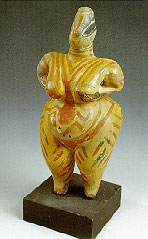
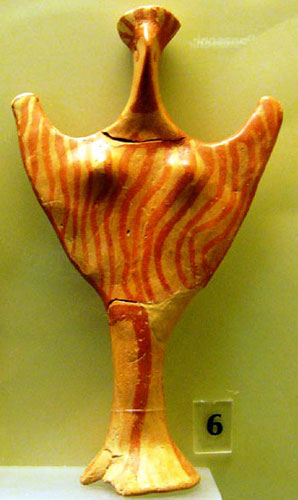
The most telling evidence for such principles being applied are furthur Melaart illustrations from Catalhoyuk;
There one sees the concern with four women of differant colour/ethnicity, totally remarkable for such a period, held in pairs upon the arms of a Goddess type, to make the point of what this is concerned with goats of differant colours are also shown, the message here is of an unequivocal nature, a concern with birthing and differances of colour and how these are interlinked.
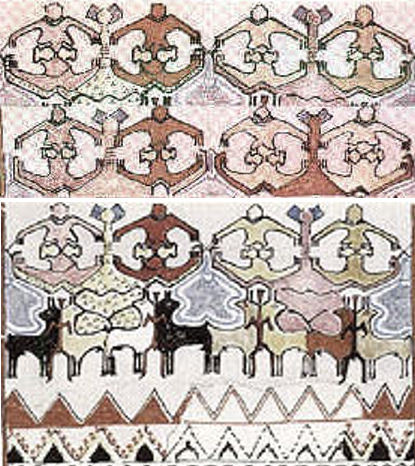
This furthur seen in this fantastical example, were the patterns and numerics of such concerns are produced;

That motif in particular seen often reproduced in architectural form at Catalhoyuk;
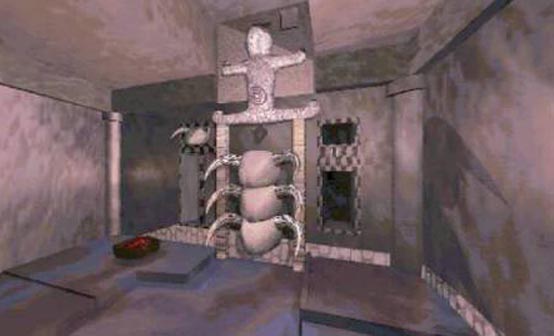
The question will always return then to what caused these people to set up their societies in such a way that unarguably a new type of people was produced, differing in physical appearance and behavioural practises than any previously, was this happy accident or by design.
What is apparant is that the people themselves understood the principles that were being applied and furthur practised them in terms of plant and animal domestication, and that they would have understood that the first such breeding programme involved themselves.
One naturally has to consider the role of the Gods, in the stories from thousands of years later these are given the critical role in the establishment of formative sociteties, of these early peoples themselves there remains only the iconography to be evaluated
The patterns that they associated with reproduction lend themselves to comparison with modern diagrams regarding the structure of DNA.
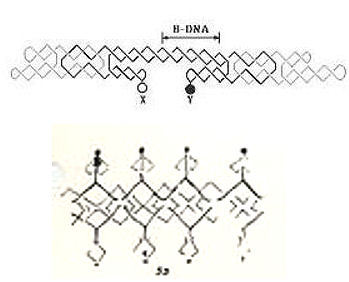
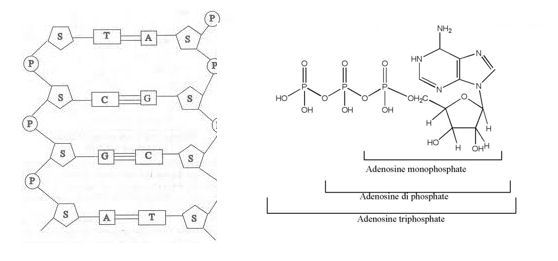
Whether by accident or design of course open to debate, but certainly there are far more questions than answers regarding what occured in the core Neolithic region. Pattern was though certainly a highly important aspect of their lives, and this has been my primary approach in attempting to understand them
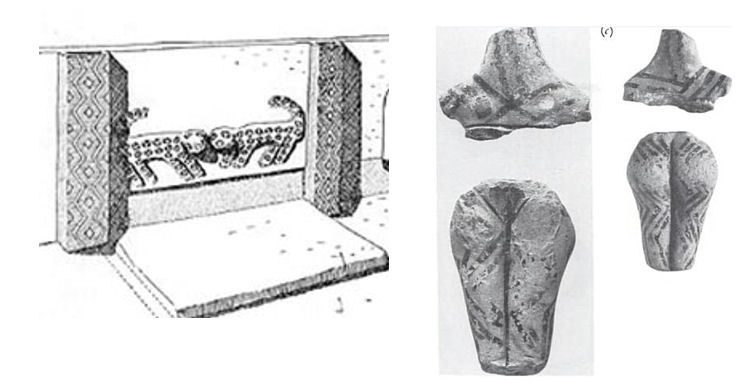



This only really makes sense then, if subservience to the principle of the Queen Bee type figure was accepted within the community as an end worthy of the means.


The most telling evidence for such principles being applied are furthur Melaart illustrations from Catalhoyuk;
There one sees the concern with four women of differant colour/ethnicity, totally remarkable for such a period, held in pairs upon the arms of a Goddess type, to make the point of what this is concerned with goats of differant colours are also shown, the message here is of an unequivocal nature, a concern with birthing and differances of colour and how these are interlinked.

This furthur seen in this fantastical example, were the patterns and numerics of such concerns are produced;

That motif in particular seen often reproduced in architectural form at Catalhoyuk;

The question will always return then to what caused these people to set up their societies in such a way that unarguably a new type of people was produced, differing in physical appearance and behavioural practises than any previously, was this happy accident or by design.
What is apparant is that the people themselves understood the principles that were being applied and furthur practised them in terms of plant and animal domestication, and that they would have understood that the first such breeding programme involved themselves.
One naturally has to consider the role of the Gods, in the stories from thousands of years later these are given the critical role in the establishment of formative sociteties, of these early peoples themselves there remains only the iconography to be evaluated
The patterns that they associated with reproduction lend themselves to comparison with modern diagrams regarding the structure of DNA.


Whether by accident or design of course open to debate, but certainly there are far more questions than answers regarding what occured in the core Neolithic region. Pattern was though certainly a highly important aspect of their lives, and this has been my primary approach in attempting to understand them


For those who might question whether such socities could have been formed as the basis for creating a new people, then i would offer the example of
the origin of the 'Chosen People', Israel.
The biblical origins of Israel are set in Northern Syria, around Harran, the core Neolitihc region, thousands of years after the what i have provided the evidence for, and involve the a group of Semitic people at the Northernmost extent of the Semite migrations from the Arabian peninsula.
These Northernmost Semites, the Arameans, established city states in the region, in particular Ebla, and were notable for their linguistic and literary skills, in that they produced documents in both Sumerian and Akkadian, and established strong scribal roles within society, they also intermarried with the Syrian populace of the time, at least at the Dynastic level, as this is recorded.
The evidence from Ebla has suggested that there proto-Hebraic developed, and everything in general supports the origins of Israel in that region.
What has interested me then, in connection with considerations of a Neolithic breeding programme, is how in Genesis the birthing of the sons of Israel is interwoven with the story of breeding cattle/flocks, i already showed how this association was seen at Catalhoyuk.
In the Genesis story it is the daughters of Laban, and two concubines, who provided the matriarchal lineage of Israel, Laban literally translates as 'white', and the suggestion then is of intermarriage between a branch of the Northern Semites, to which Laban belonged, and the 'whites' of the region through taking of wives, which is seen in the lineage of the daughters of Laban, Rachel and Leah.
The story is best seen with the Hebrew compared to the English, as provided here;
www.scripture4all.org...
but as i said, interwoven with the birthing of the sons of Israel is the tale of the division of the flocks, Laban, Mr White, will keep the whole white livestock, whilst Jacob/Israel will keep the speckled or wholly brown, thus Israel will have admixture with the white, to extend the allegory, but will never be white as such, as the patriarchal element is Semitic.
It's remarkable the Mit DNA analysis of Jewish people supports this story, in that the Mit DNA is considered to trace back to four differant women of European type orgin (though unlikely they were ever in Europe rather Syria), whislt male DNA is Semitic.
Thus the biblical narrative, and the actual genetic evidence, supports the concern with creating a people of a particular type, and the importance that was attatched to retaining this genetic basis, in terms of not taking the wives of other Semitic tribes after the establishment for the basis of Israel.
What the Hebrews in essence did was graft themselves into the people and importantly the traditions, of the core Neolithic region.
The biblical origins of Israel are set in Northern Syria, around Harran, the core Neolitihc region, thousands of years after the what i have provided the evidence for, and involve the a group of Semitic people at the Northernmost extent of the Semite migrations from the Arabian peninsula.
These Northernmost Semites, the Arameans, established city states in the region, in particular Ebla, and were notable for their linguistic and literary skills, in that they produced documents in both Sumerian and Akkadian, and established strong scribal roles within society, they also intermarried with the Syrian populace of the time, at least at the Dynastic level, as this is recorded.
The evidence from Ebla has suggested that there proto-Hebraic developed, and everything in general supports the origins of Israel in that region.
What has interested me then, in connection with considerations of a Neolithic breeding programme, is how in Genesis the birthing of the sons of Israel is interwoven with the story of breeding cattle/flocks, i already showed how this association was seen at Catalhoyuk.
In the Genesis story it is the daughters of Laban, and two concubines, who provided the matriarchal lineage of Israel, Laban literally translates as 'white', and the suggestion then is of intermarriage between a branch of the Northern Semites, to which Laban belonged, and the 'whites' of the region through taking of wives, which is seen in the lineage of the daughters of Laban, Rachel and Leah.
The story is best seen with the Hebrew compared to the English, as provided here;
www.scripture4all.org...
but as i said, interwoven with the birthing of the sons of Israel is the tale of the division of the flocks, Laban, Mr White, will keep the whole white livestock, whilst Jacob/Israel will keep the speckled or wholly brown, thus Israel will have admixture with the white, to extend the allegory, but will never be white as such, as the patriarchal element is Semitic.
It's remarkable the Mit DNA analysis of Jewish people supports this story, in that the Mit DNA is considered to trace back to four differant women of European type orgin (though unlikely they were ever in Europe rather Syria), whislt male DNA is Semitic.
Thus the biblical narrative, and the actual genetic evidence, supports the concern with creating a people of a particular type, and the importance that was attatched to retaining this genetic basis, in terms of not taking the wives of other Semitic tribes after the establishment for the basis of Israel.
What the Hebrews in essence did was graft themselves into the people and importantly the traditions, of the core Neolithic region.
edit on 31-8-2012 by Kantzveldt because: typo
Excellent post. S&F. I would assume the basic strive and instinct to produce successful/strong offsprings was/has/is always been at the front. Most
species strive to find a strong and healthy partner that can bear the offsprings and pass on the healthy genes to the next generation. This is
evident atleast in the non-human species. Even in the humans, the search is for a powerful/wealthy partner if not a healthy and good looking one.
However this varies according to the cultures.
Holy wow. This is some crazy stuff you put forth here. It does seem like a neolithic society managed to create a kind of culture involving both
genetic diversity and selective breeding of which many elements were spread very far. The honeycomb motif I find very interesting in particular. It
seems very important and very highly conserved across many distant cultures. It reminds me of the principle in biology where the more highly conserved
(staying the same across many species) a gene is, the more critical it usually is.
Nice thread, lots of well sourced information and very well presented, and logical content. S&F
I think this is very relevant research and very well possible.
That ancient cultures were interested in the thing we now know as genetics would have been all too prevalent then. Survival was more on their minds and the qualities that emerged from pairings would be important, as would general qualities observed within tribal families.
The establishment of particular groups within Neolithic cultures and their growth would very likely have been intelligently practiced rather than lots of random events.
The very fact these things were obviously considered, as well as considering higher intelligence's such as those explored in religious practices shows the level of intellect.
Interestingly these observations in this thread, linked to Judaic practices, including matriarchal lineage could also show significance in maintaining tribal qualities and the continuation of lineage, which Judaism takes particular interest in.
I think this is very relevant research and very well possible.
That ancient cultures were interested in the thing we now know as genetics would have been all too prevalent then. Survival was more on their minds and the qualities that emerged from pairings would be important, as would general qualities observed within tribal families.
The establishment of particular groups within Neolithic cultures and their growth would very likely have been intelligently practiced rather than lots of random events.
The very fact these things were obviously considered, as well as considering higher intelligence's such as those explored in religious practices shows the level of intellect.
Interestingly these observations in this thread, linked to Judaic practices, including matriarchal lineage could also show significance in maintaining tribal qualities and the continuation of lineage, which Judaism takes particular interest in.
reply to post by hp1229
Thanks, i think that as far as an individual choosing a mate goes this will be based on instinctive attraction and sociological considerations certainly, with desirable outcomes factored in.
As far as any breeding programme goes you'll understand the nature of your biological factors and again have some notion of what you want to produce and why. Examples of human societies even considering such things in terms of being applied to themselves are of course rare, the Lebensborn project being the best known example, though this very limited in extent.
That the early Neoltihic people ever concieved of such a project of course fantastical, with outside agency for any such undertaking highly likely.
Thanks, i think that as far as an individual choosing a mate goes this will be based on instinctive attraction and sociological considerations certainly, with desirable outcomes factored in.
As far as any breeding programme goes you'll understand the nature of your biological factors and again have some notion of what you want to produce and why. Examples of human societies even considering such things in terms of being applied to themselves are of course rare, the Lebensborn project being the best known example, though this very limited in extent.
That the early Neoltihic people ever concieved of such a project of course fantastical, with outside agency for any such undertaking highly likely.
reply to post by Kantzveldt
Visualising tribal leaders, with perhaps a necessity for expanding into other areas, or for expanding the gene pool, having trades with other tribes and becoming aware of certain tribes having desirable qualities.
These leaders then making decisions for intermarriage agreements between tribes ABC, chosen for their specific qualities and making rules that ensure such pacts are kept to desirable group pairings, Leading to successful dominant groups.
The unsuccessful groups being phased out due to non or undesirable procreation and competition for resources.
Visualising tribal leaders, with perhaps a necessity for expanding into other areas, or for expanding the gene pool, having trades with other tribes and becoming aware of certain tribes having desirable qualities.
These leaders then making decisions for intermarriage agreements between tribes ABC, chosen for their specific qualities and making rules that ensure such pacts are kept to desirable group pairings, Leading to successful dominant groups.
The unsuccessful groups being phased out due to non or undesirable procreation and competition for resources.
I would assume its pretty simple and/or common sense brought to you by the coutesy of Nature and its surroundings In this case, the bees were their inspiration to even conceive such a program. The american indians are among many group of people where each tribe used or followed the learnings based on a particular species of animal (wolves, eagle, coyote etc etc). Similarly there are others around the world where their religious views and/or fundamental principles revolve around nature and certainly animals including the Hindus where many of them are worshipped as gods. I'm just curious and wondering as per how much have the animals learned from humans OTOH Ofcourse there are few examples but not many.
Originally posted by Kantzveldt
reply to post by hp1229
That the early Neoltihic people ever concieved of such a project of course fantastical, with outside agency for any such undertaking highly likely.
The female aspect of these religions of the area and era ties with beehive strategies.
Also very interesting is the proposal that women were perhaps the precursors of modern civilization via cultivation.
A lot is often learned through practical application of things, such as the realisation of fertilisation techniques giving better crop, specific qualities in fruits being more desirable etc, this is easily translated (and most probably an obvious link for these agricultural women) and applied when considering a mate for procreation.
ETA Perhaps they also knew of the importance of bees in the pollination process, and kept hives for this purpose. How relevant this is on Earth now. Bees are so important to humanity. Perhaps they farmed clay pot hives for ensured resources.
The patterns of these eras are still seen in traditonal weaving patterns of many areas.
Goddess in Western Literature
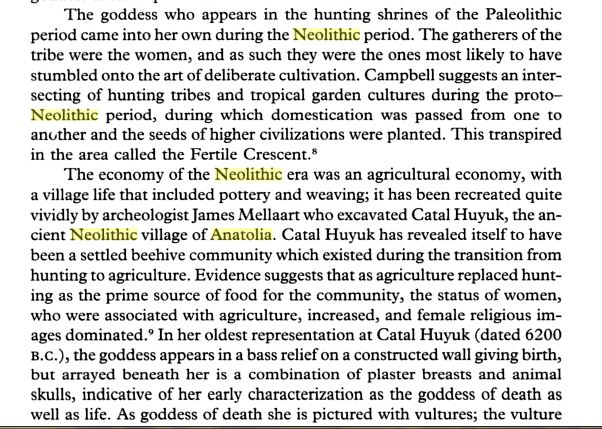
Also very interesting is the proposal that women were perhaps the precursors of modern civilization via cultivation.
A lot is often learned through practical application of things, such as the realisation of fertilisation techniques giving better crop, specific qualities in fruits being more desirable etc, this is easily translated (and most probably an obvious link for these agricultural women) and applied when considering a mate for procreation.
ETA Perhaps they also knew of the importance of bees in the pollination process, and kept hives for this purpose. How relevant this is on Earth now. Bees are so important to humanity. Perhaps they farmed clay pot hives for ensured resources.
The patterns of these eras are still seen in traditonal weaving patterns of many areas.
Goddess in Western Literature

edit on 31-8-2012 by theabsolutetruth because: (no reason given)
edit on 31-8-2012 by
theabsolutetruth because: (no reason given)
reply to post by Mkoll
Yes it's certainly wild, i've wrote previously of the importance of Bee cults, generally they can give ancient aliens good competition as far as origins of early civilizations go, though perhaps the two aren't neccesarily exclusive...
www.abovetopsecret.com...
Yes it's certainly wild, i've wrote previously of the importance of Bee cults, generally they can give ancient aliens good competition as far as origins of early civilizations go, though perhaps the two aren't neccesarily exclusive...
www.abovetopsecret.com...
reply to post by theabsolutetruth
Thanks for the replies, and you add many good points. What i've suggested does i hope lead to a greater appreciation of what was involved in the elevated status of a birth Goddess, and a deeper understanding of the associated iconography and importance of the language of pattern.
The Hebrews did certainly understand from their onset the importance of retaining characteristics that could only be transmitted through the matriarchal lineage, and that has been the secret of their success, that they adopted into this practise in the core Neolithic region no coincidence, as like i said they were grafting on to what had been manifest millenia previously, through the same practise.
Thanks for the replies, and you add many good points. What i've suggested does i hope lead to a greater appreciation of what was involved in the elevated status of a birth Goddess, and a deeper understanding of the associated iconography and importance of the language of pattern.
The Hebrews did certainly understand from their onset the importance of retaining characteristics that could only be transmitted through the matriarchal lineage, and that has been the secret of their success, that they adopted into this practise in the core Neolithic region no coincidence, as like i said they were grafting on to what had been manifest millenia previously, through the same practise.
reply to post by hp1229
Yes, i guess that's the essense of wisdom philosophy, that first one directly observes a particular aspect of nature, perhaps imitating it, and then consider the greater metaphysical patterns behind the aspect in terms of Divine Schematics.
I'm not sure what if anything other species might have picked up from us, painting on canvas and jumping through hoops probably not helping any of them much.
Yes, i guess that's the essense of wisdom philosophy, that first one directly observes a particular aspect of nature, perhaps imitating it, and then consider the greater metaphysical patterns behind the aspect in terms of Divine Schematics.
I'm not sure what if anything other species might have picked up from us, painting on canvas and jumping through hoops probably not helping any of them much.
reply to post by Kantzveldt
Many thanks for a great thread as usual, you seems to sieve an enormous amount of ancient knowledge and then sprinkle it in to words that are easy on the palette.As I digest the thread it offers many answers to the questions I ponder and I am sure I will benefit from them in the future.
This is a rather simple hypothesis, but how about if in different regions they became aware that a disease was killing off people fast. Imagine the leaders come together and know that there are certain types of races that are not effected by this disease. After some time, for the benefit of all, a program is established.I can see that it would be relatively easy for people to volunteer their bodies for such a noble cause.Soon a school of thought would be set up on the site, to study the effects of the program.It can be considered to be a rather dark venture or on the other hand and essential step to take.As they get certain results,new programs could come out. In some areas this could have gone on for hundreds of years.
I remember reading in ancient Irish folklore there were stories of foreign people coming and taking babies. Perhaps they used to deliver a few also. Secretly this may have gone on in many different parts of the world once one group understood what they were doing and where getting some good results.
Two questions, of who is that marble face in your avatar and if you don't mind why did you choose it?
Many thanks for a great thread as usual, you seems to sieve an enormous amount of ancient knowledge and then sprinkle it in to words that are easy on the palette.As I digest the thread it offers many answers to the questions I ponder and I am sure I will benefit from them in the future.
This is a rather simple hypothesis, but how about if in different regions they became aware that a disease was killing off people fast. Imagine the leaders come together and know that there are certain types of races that are not effected by this disease. After some time, for the benefit of all, a program is established.I can see that it would be relatively easy for people to volunteer their bodies for such a noble cause.Soon a school of thought would be set up on the site, to study the effects of the program.It can be considered to be a rather dark venture or on the other hand and essential step to take.As they get certain results,new programs could come out. In some areas this could have gone on for hundreds of years.
I remember reading in ancient Irish folklore there were stories of foreign people coming and taking babies. Perhaps they used to deliver a few also. Secretly this may have gone on in many different parts of the world once one group understood what they were doing and where getting some good results.
Two questions, of who is that marble face in your avatar and if you don't mind why did you choose it?
reply to post by Kantzveldt
the other idea that came to mind soon after my last reply, was perhaps it was not disease but rather infertility. Male infertility and this was leading to many regions not having children.It would explain the bottleneck and perhaps the placements of the sites.
the other idea that came to mind soon after my last reply, was perhaps it was not disease but rather infertility. Male infertility and this was leading to many regions not having children.It would explain the bottleneck and perhaps the placements of the sites.
reply to post by ancientthunder
I think it more likely that a programme would have been an aspect of religious beliefs, in order for it to have been maintained for the neccesary extensive periods. There was a basic colour symbolism prevalent were black represented the Underworld and associated spirits, red the terrestial and the life blood of the people (the most commonly seen colour at Catalhoyuk), and white represented the upperworld/Heavens, and associated spirits.
The evidence of the white mother Goddess illustrations suggests they would have practised selective reproduction practise toward this desired result, the tree of life symbol, the ladder to Heaven, the double-helix serpent, these are the means to the end...this is contentious.
When you mention the switching of new-borns by the fasirie folk this is amusing as my mother always said this must have occured with me, failing to appreciate certain traits in her offspring, i don't think it's true though.
The avatar is of an ivory mask of Apollo 5th century BC, protector of herds and flocks, amongst other things, a Deity that traversed the gulf between the darkest depths and the brightest Heavens.
I think it more likely that a programme would have been an aspect of religious beliefs, in order for it to have been maintained for the neccesary extensive periods. There was a basic colour symbolism prevalent were black represented the Underworld and associated spirits, red the terrestial and the life blood of the people (the most commonly seen colour at Catalhoyuk), and white represented the upperworld/Heavens, and associated spirits.
The evidence of the white mother Goddess illustrations suggests they would have practised selective reproduction practise toward this desired result, the tree of life symbol, the ladder to Heaven, the double-helix serpent, these are the means to the end...this is contentious.
When you mention the switching of new-borns by the fasirie folk this is amusing as my mother always said this must have occured with me, failing to appreciate certain traits in her offspring, i don't think it's true though.
The avatar is of an ivory mask of Apollo 5th century BC, protector of herds and flocks, amongst other things, a Deity that traversed the gulf between the darkest depths and the brightest Heavens.
reply to post by Kantzveldt
Interbreeding coupled with natural selection will do the same in a few generations – even a single generation – if the selective pressures are strong enough. That is precisely what is meant by a 'genetic bottleneck'. A plague to which all except carriers of a particular gene succumb, will do the trick nicely.
'Of course fantastical'? Even though they were busily engaged in selectively breeding farm animals at the time? Why is it be fantastical that someone should apply the same methods to people?
Interbreeding coupled with selection pressure, a virulent plague or other natural disaster, or even a Neolithic Hitler indulging in ethnic cleansing and primitive eugenics – all these are far more likely than 'aliens did it.'
The given reason for these profound changes from the core Neolithic region is that a 'genetic bottleneck' had occured, which is to say a great many diverse variations went into the mix, but what emerged was of a more particular nature, which is of course what one will observe with any programme of selective breeding.
Interbreeding coupled with natural selection will do the same in a few generations – even a single generation – if the selective pressures are strong enough. That is precisely what is meant by a 'genetic bottleneck'. A plague to which all except carriers of a particular gene succumb, will do the trick nicely.
That the early Neoltihic people ever concieved of such a project of course fantastical, with outside agency for any such undertaking highly likely.
'Of course fantastical'? Even though they were busily engaged in selectively breeding farm animals at the time? Why is it be fantastical that someone should apply the same methods to people?
Interbreeding coupled with selection pressure, a virulent plague or other natural disaster, or even a Neolithic Hitler indulging in ethnic cleansing and primitive eugenics – all these are far more likely than 'aliens did it.'
reply to post by Astyanax
I think the entirely natural plague scenario a possibility but of course entirely unevidenced, whereas there is the suggestion of unusual social practise at Catalhoyuk, there is also this;
www.catalhoyuk.com...
The most striking element about the human remains recovered at Çatalhöyük in 2005 is the high number of neonates, infants, and children found in the Neolithic deposits. In the 4040 area alone, 21 neonates were found this season, 14 of which were found in relatively close proximity to one another. The total number of individuals who died before adolescence (i.e., neonates, infants, and older children) found this season comprises 55% of the Neolithic sample
It also needs to be kept in mind that the domestication of plants and animals followed on after the the development of the Neolithic type settlements and the associate people themselves arose, thus they seemingly learnt methodology from whatever principles had been applied within their own society, and of course that was not attempting to introduce plague into livestock and hoping for the best.
Religious and spiritual practise i would as stated consider the most likely factor for the social practises that would have introduced selective reproduction within their society, alien intervention a possibility but far less likely and not neccesary, it only remains a suggestion because of the later mythological traditions from the region in terms of the descent of the watchers.
I think the entirely natural plague scenario a possibility but of course entirely unevidenced, whereas there is the suggestion of unusual social practise at Catalhoyuk, there is also this;
www.catalhoyuk.com...
The most striking element about the human remains recovered at Çatalhöyük in 2005 is the high number of neonates, infants, and children found in the Neolithic deposits. In the 4040 area alone, 21 neonates were found this season, 14 of which were found in relatively close proximity to one another. The total number of individuals who died before adolescence (i.e., neonates, infants, and older children) found this season comprises 55% of the Neolithic sample
It also needs to be kept in mind that the domestication of plants and animals followed on after the the development of the Neolithic type settlements and the associate people themselves arose, thus they seemingly learnt methodology from whatever principles had been applied within their own society, and of course that was not attempting to introduce plague into livestock and hoping for the best.
Religious and spiritual practise i would as stated consider the most likely factor for the social practises that would have introduced selective reproduction within their society, alien intervention a possibility but far less likely and not neccesary, it only remains a suggestion because of the later mythological traditions from the region in terms of the descent of the watchers.
In order to create state, you need population.
In order to create vast population, you need food. And priestesses-whores, for instance. And "goddess" of fertility.
Food you get from animals and agriculture.
Further on, you need various skills. Masonry, for instance. Also, political ideology (religion).
Then you build pyramids, as political factories, to mark and start technology transfer (of state) around the world.
This is all to materialize an idea. Nothing more than that.
We are still victims of that.
In order to create vast population, you need food. And priestesses-whores, for instance. And "goddess" of fertility.
Food you get from animals and agriculture.
Further on, you need various skills. Masonry, for instance. Also, political ideology (religion).
Then you build pyramids, as political factories, to mark and start technology transfer (of state) around the world.
This is all to materialize an idea. Nothing more than that.
We are still victims of that.
reply to post by Kantzveldt
Outstanding thread. But the "aliens did it" idea took a shoehorn to apply here. As stated, a Fertility Goddess cult would easily spring up when knowledge began to be noticed among women and not men. Any time you saw knowledge of the sciences in ancient times, you saw a cult of one form or another spring up. "The Mysteries", or the secret knowledge of the biblical and classical periods have given rise to the ideas that led to the founding of America (and which have subsequently been destroyed in America).
It is just knowledge of how reality/nature works. Kind of like having cheat codes to the video game of life. And, at the time of domestication of crops and stock animals, this happened to be women holding these cheat codes, and thus exerting considerable influence over the societies that their knowledge benefitted.
Outstanding thread. But the "aliens did it" idea took a shoehorn to apply here. As stated, a Fertility Goddess cult would easily spring up when knowledge began to be noticed among women and not men. Any time you saw knowledge of the sciences in ancient times, you saw a cult of one form or another spring up. "The Mysteries", or the secret knowledge of the biblical and classical periods have given rise to the ideas that led to the founding of America (and which have subsequently been destroyed in America).
It is just knowledge of how reality/nature works. Kind of like having cheat codes to the video game of life. And, at the time of domestication of crops and stock animals, this happened to be women holding these cheat codes, and thus exerting considerable influence over the societies that their knowledge benefitted.
new topics
-
Rainbow : Stargazer
Music: 26 minutes ago -
I sleep no more.
Philosophy and Metaphysics: 2 hours ago -
Canada caught red-handed manipulating live weather data and make it warmer
Fragile Earth: 3 hours ago -
Why Files Our Alien Overlords | How We Secretly Serve The Tall Whites
Aliens and UFOs: 4 hours ago -
Curse of King Tuts Tomb Solved
Ancient & Lost Civilizations: 5 hours ago -
What allies does Trump have in the world?
ATS Skunk Works: 5 hours ago
top topics
-
BIDEN Admin Begins Planning For January 2025 Transition to a New President - Today is 4.26.2024.
2024 Elections: 14 hours ago, 10 flags -
Canada caught red-handed manipulating live weather data and make it warmer
Fragile Earth: 3 hours ago, 10 flags -
Big Storms
Fragile Earth: 16 hours ago, 9 flags -
Why Files Our Alien Overlords | How We Secretly Serve The Tall Whites
Aliens and UFOs: 4 hours ago, 8 flags -
Curse of King Tuts Tomb Solved
Ancient & Lost Civilizations: 5 hours ago, 6 flags -
What allies does Trump have in the world?
ATS Skunk Works: 5 hours ago, 3 flags -
I sleep no more.
Philosophy and Metaphysics: 2 hours ago, 1 flags -
Rainbow : Stargazer
Music: 26 minutes ago, 0 flags
active topics
-
Canada caught red-handed manipulating live weather data and make it warmer
Fragile Earth • 11 • : DerBeobachter2 -
I sleep no more.
Philosophy and Metaphysics • 6 • : AcrobaticDreams1 -
Shocking Number of Voters are Open to Committing Election Fraud
US Political Madness • 8 • : Kaiju666 -
Definitive 9.11 Pentagon EVIDENCE.
9/11 Conspiracies • 430 • : Zanti Misfit -
BIDEN Admin Begins Planning For January 2025 Transition to a New President - Today is 4.26.2024.
2024 Elections • 25 • : YourFaceAgain -
Krystalnacht on today's most elite Universities?
Social Issues and Civil Unrest • 21 • : TheWoker -
Do you ever just get "bored" of everything?
Rant • 24 • : Cvastar -
University of Texas Instantly Shuts Down Anti Israel Protests
Education and Media • 341 • : CriticalStinker -
So this is what Hamas considers 'freedom fighting' ...
War On Terrorism • 273 • : YourFaceAgain -
Rainbow : Stargazer
Music • 0 • : gortex
